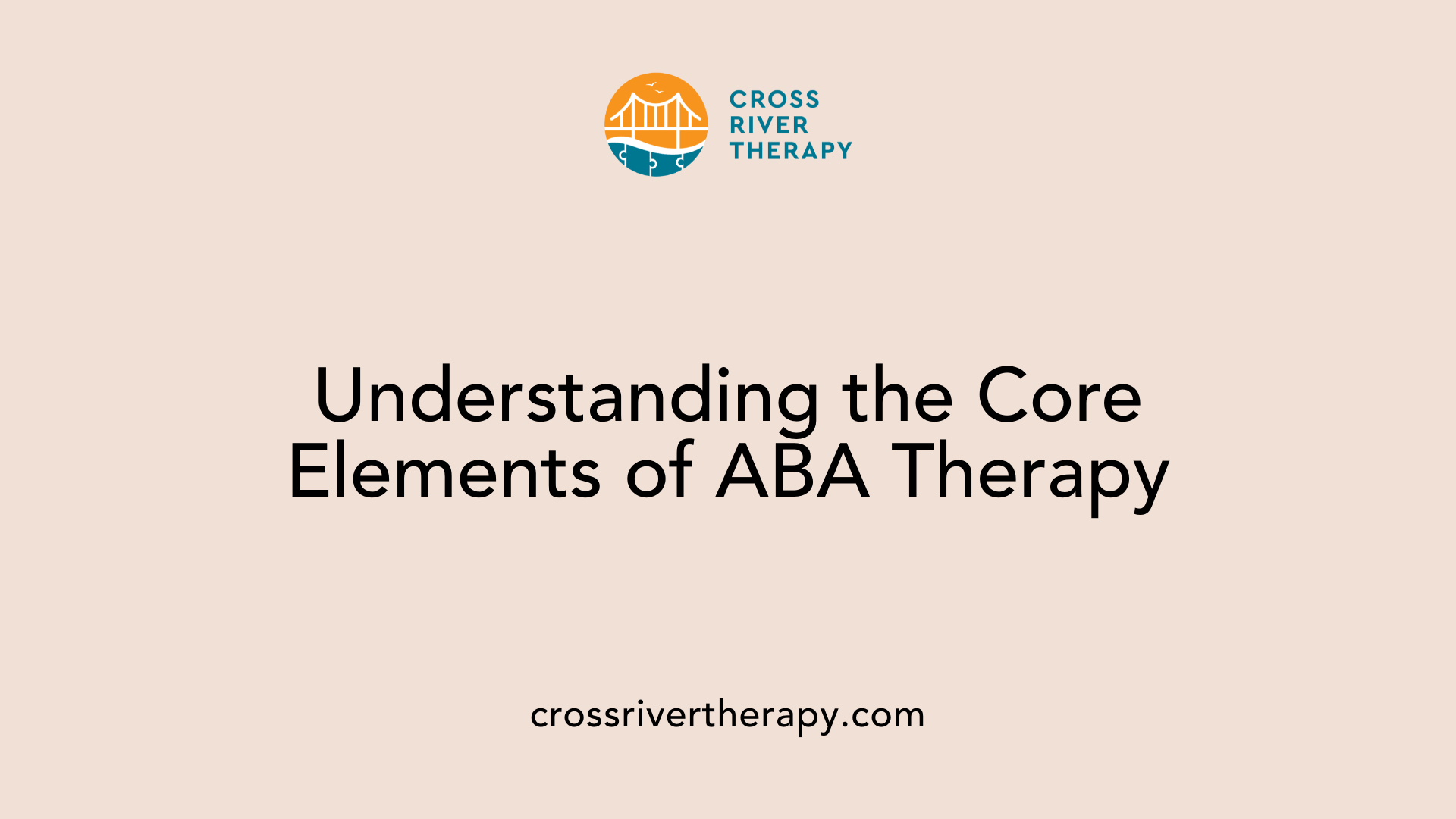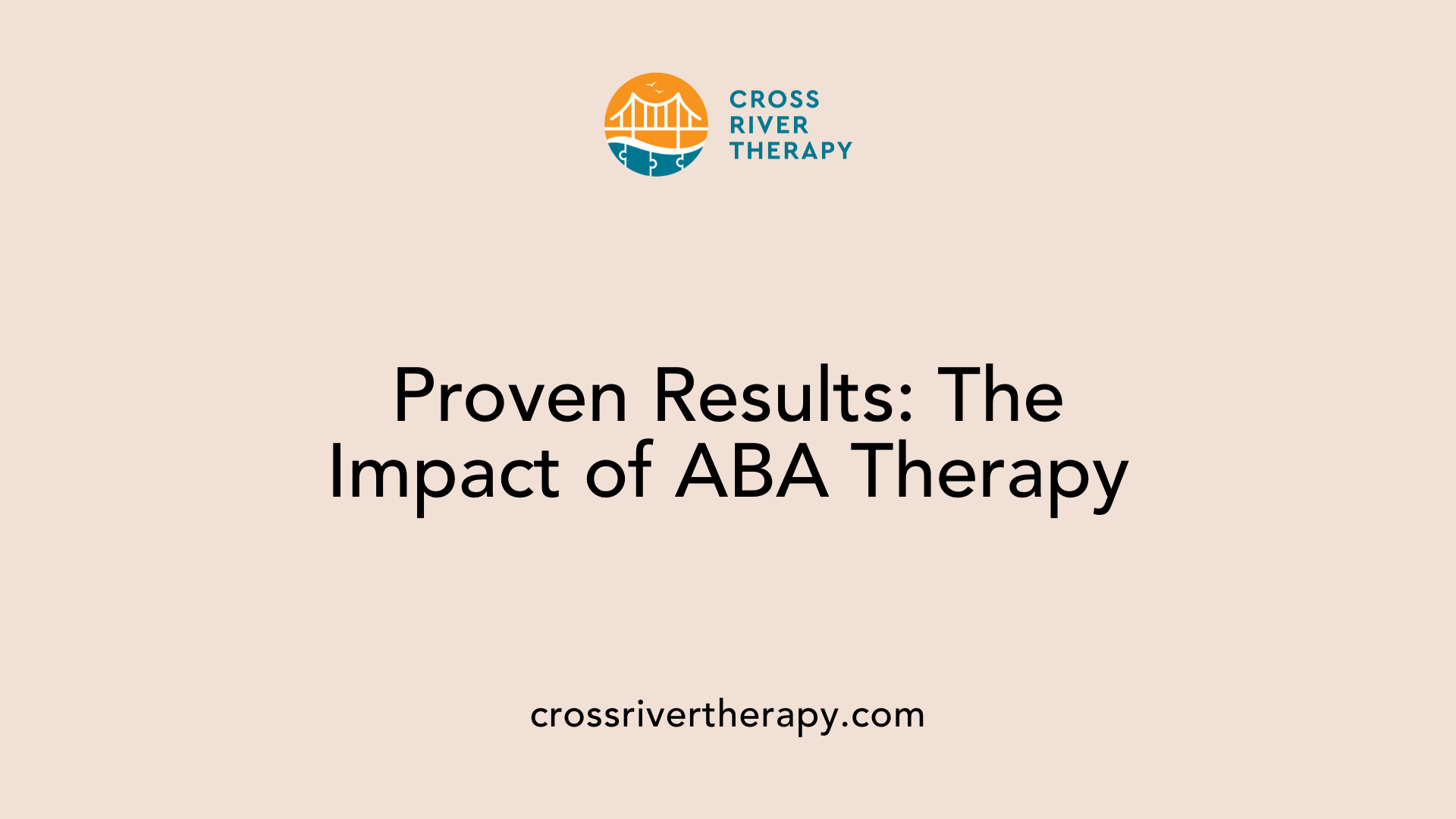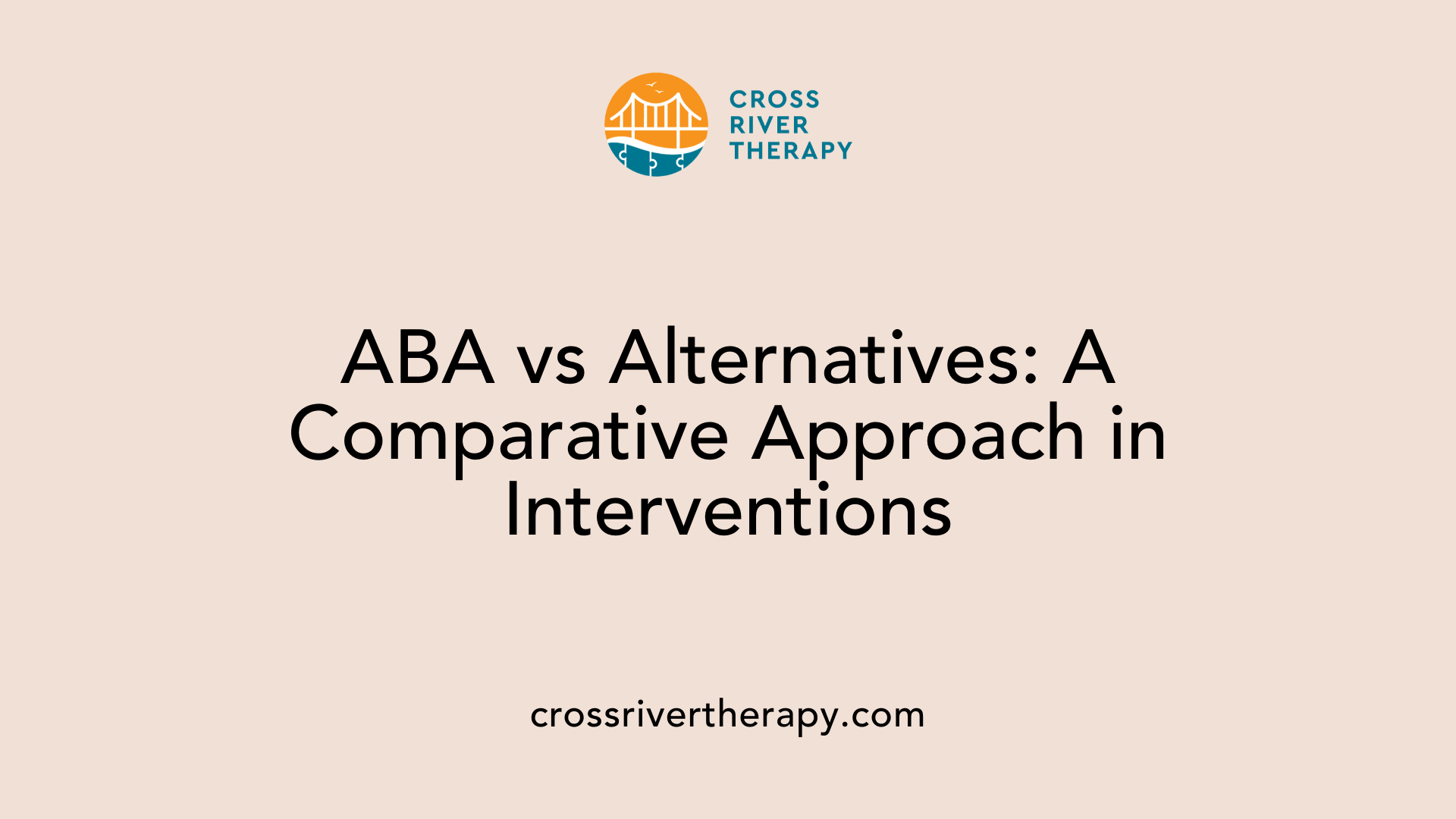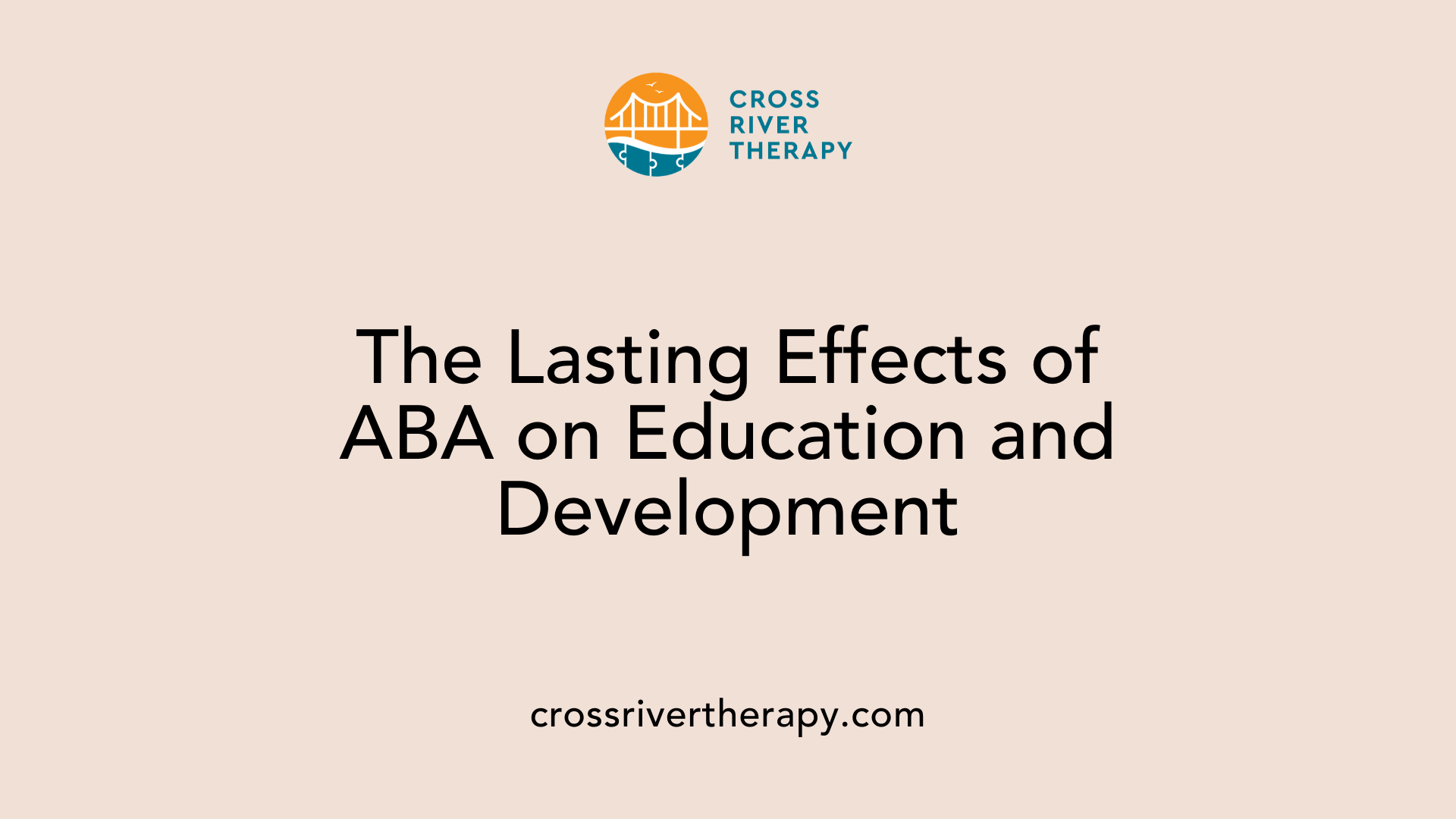ABA Therapy and Its Impact on Academic Performance in Children with Autism
Unpacking the Role of ABA Therapy in Academic Advances for Autism
Understanding ABA Therapy’s Core Purpose
Applied Behavior Analysis (ABA) therapy stands as a pivotal treatment for children with Autism Spectrum Disorder (ASD), uniquely tailored to individual needs to pave the way for significant improvements across various development domains. This scientific approach not only enhances desirable behaviors but also refines the skillsets necessary for academic success. With a robust foundation in evidence-based practices, ABA therapy's impact on academic performance, social interaction, and cognitive abilities offers profound insights into its role as a transformative intervention for children with autism.
What Constitutes Applied Behavior Analysis Therapy?

Understanding ABA therapy
Applied Behavior Analysis (ABA) therapy is a leading evidence-based approach aimed at enhancing the behavioral and developmental skills of children with autism spectrum disorder (ASD). It operates on the principle that desired behaviors can be encouraged through reinforcement and that less desirable behaviors can be decreased through structured interventions. Techniques such as positive reinforcement, as well as the ABCs of behavior—Antecedent, Behavior, and Consequence—help decipher and modify behaviors effectively.
How ABA promotes behavioral changes in autism
Tailoring the therapy to meet individual needs is essential; a qualified behavior analyst conducts comprehensive assessments to devise personalized treatment plans. Studies indicate that children undergoing early and sustained ABA interventions experience significant improvements in various domains. These include:
- Communication Skills: Enhanced ability to articulate thoughts and interact socially.
- Social Interaction: Improved skills in engaging with peers, recognizing social cues, and participating in group activities.
- Daily Living Skills: Increases in self-care abilities, contributing to greater autonomy.
Research illustrates that ABA can lead to meaningful gains in areas such as academic performance, social communication, and the overall quality of life for children with autism. Engaging children in structured environments enhances their focus, motivation, and academic success, reinforcing the importance of this therapy in fostering positive behavior changes and developmental milestones.
The Evidence Supporting ABA’s Effectiveness

What is the evidence for the effectiveness of ABA as a treatment for autism?
Applied Behavior Analysis (ABA) is well-supported as an effective treatment for children with autism spectrum disorder (ASD). Research indicates significant benefits stemming from early and intensive ABA interventions. For instance, a review analyzing over 770 studies found that 63% to 88% reported measurable improvements in cognitive, language, and social skills among participants.
Meta-analyses further demonstrate that ABA interventions lead to positive outcomes:
- Language development shows effect sizes of 1.48 for receptive and 1.47 for expressive language.
- Intellectual functioning achieves a notable effect size of 1.19.
- Improvements in social functioning are also significant, with an effect size of 0.95.
Moreover, a specific study that focused on interpersonal skills revealed statistically significant improvements for children receiving ABA compared to a control group. These findings underscore how ABA therapy can enhance social skills, communication abilities, and everyday academic performance.
Despite a wealth of positive results, it's critical to acknowledge a gap in research—only 4% of studies employed controlled comparisons, indicating the need for further rigorous evaluation of ABA against alternative treatments. Additionally, there's scarcity in assessing quality of life outcomes, which are essential for a holistic understanding of treatment efficacy.
ABA Therapy’s Contribution to Academic Performance
What impact does ABA therapy have on academic performance in children with autism?
ABA therapy significantly enhances academic performance in children with autism by focusing on skill development essential for success in learning environments. Research has shown that children receiving ABA interventions demonstrate improvements in critical skills such as language, communication, attention, and memory. These skills form the foundation for academic achievement and independent functioning.
The application of positive reinforcement techniques within ABA therapy helps children cultivate desirable behaviors necessary for success in school. For example, reinforcing periods of focus or collaboration encourages children to adopt habits that enhance their learning experience. Moreover, children who struggle with distractions or aggressive behaviors benefit from the structured environment that ABA provides, which minimizes disruptions and promotes concentration.
Structured learning advantages
In addition to addressing behaviors, ABA therapy integrates structured social skills training tailored for classroom dynamics. This component helps children develop communication skills crucial for effective peer interactions and teamwork. By engaging with classmates positively, children are more likely to participate actively, which not only benefits their social skills but also directly supports their academic growth.
Ultimately, the structured and individualized nature of ABA therapy effectively aligns the therapeutic interventions with children’s unique needs, leading to improved academic outcomes. The documented progress in academic skills correlates with enhanced performance in social and daily living abilities, showcasing the holistic impact of ABA on children with autism.
Academic Challenges Encountered by Autistic Children
How does autism affect academic performance?
Many autistic children face various academic challenges that impede their learning potential. Key issues include:
- Flexibility Problems: Many children with autism struggle with adapting to changes in routines or strategies, leading to heightened anxiety during transitions.
- Sensory Processing Abnormalities: Sensory overload or under-stimulation can distract children, making it hard for them to focus on tasks. Environments that are too loud or chaotic may hinder their ability to learn effectively.
- Attentional Deficits: Children with autism might find it difficult to maintain focus, especially in environments filled with distractions. This can significantly impact not just their learning but also their ability to engage in classroom activities.
These challenges create discrepancies between their intellectual abilities and actual academic performance, often resulting in frustration for both the child and educators.
Despite these hurdles, ABA therapy has been shown to positively influence academic skills by enhancing communication, improving focus, and promoting social interaction. The structured and supportive nature of ABA creates an engaging learning environment that helps to mitigate some of these academic challenges. By tailoring ABA techniques to individual needs, children can develop coping strategies that contribute to their overall academic success and independence.
Comparative Analysis: ABA Versus Other Interventions

How does ABA therapy compare to other treatments in its impact on academic performance for children with autism?
Applied Behavior Analysis (ABA) has emerged as a leading therapeutic approach for children with autism spectrum disorder (ASD), primarily due to its evidence-based effectiveness. Numerous studies have indicated that ABA can significantly improve academic performance, especially through its structured, data-driven methodologies. For instance, a study involving 98 participants demonstrated strong statistically significant improvements in mastering learning targets through ABA intervention, with p-values showing robust effectiveness.
Key techniques such as Discrete Trial Training and Natural Environment Training embedded within ABA frameworks have been essential in promoting cognitive, language, and social skills—all critical components for academic success. These methods ensure that therapy is tailored to individual learning needs, allowing children to make notable advancements across various skill domains. Regular engagement in ABA sessions brings about enhanced independence, as children become more capable of managing academic tasks autonomously.
| Outcome | ABA Improvement | Other Interventions |
|---|---|---|
| Academic Skills | Significant improvements reported | Often variable and less structured |
| Social Skills | Enhanced peer interactions | Limited focus in treatment |
| Daily Living Skills | Noteworthy development | Mixed results across therapies |
| Language Skills | Strong advancement in both receptive and expressive capabilities | Lacks comprehensive approach |
Furthermore, while many alternative interventions exist, ABA stands out for its unique ability to consistently reshape behaviors in a structured environment. Regulatory organizations such as the US Surgeon General and the American Psychological Association have recognized its effectiveness, thereby supporting its use over other, less empirically validated strategies. Even within the context of these alternatives, ABA is favorably positioned, facilitating not only academic proficiency but also overall development in children with ASD.
In summary, ABA therapy demonstrates statistically significant improvements in academic performance compared to other approaches, reinforcing its value as a comprehensive intervention strategy for enhancing the learning experiences of children with autism spectrum disorder.
ABA Methodologies and Their Application
ABC Model
The ABC model in ABA stands for Antecedent, Behavior, and Consequence. This framework helps therapists identify the triggers that lead to specific behaviors, analyze the behaviors themselves, and understand the outcomes that follow. For children with autism spectrum disorder (ASD), identifying these elements is crucial to develop strategies that foster desirable behaviors and reduce maladaptive ones. By effectively modeling and modifying these behaviors, progress in social, academic, and daily living skills can be achieved.
Positive Reinforcement
One of the core principles of ABA is positive reinforcement, which involves rewarding desirable behaviors to increase their occurrence. By providing rewards such as praise or tangible items when a child exhibits target behaviors, therapists can encourage these actions to become habitual. This technique is particularly effective in improving academic performance, as it motivates children to engage in specific tasks and skills relevant to their learning objectives.
Individualized Assessments
ABA therapy is tailored to the needs of each child through individualized assessments. Tools like the ABLLS-R protocol are employed to measure a child’s language and social communication abilities. This tailored approach ensures that the therapeutic interventions address each child’s unique challenges and strengths, allowing for more targeted and effective outcomes. The use of software for progress tracking further enhances the precision of these assessments and aids in refining therapy strategies as needed.
| Methodology | Description | Impact on Skills |
|---|---|---|
| ABC Model | Analyzes triggers and responses to behaviors | Enhances behavior modification |
| Positive Reinforcement | Rewards desired behaviors to encourage repetition | Improves academic engagement |
| Individualized Assessments | Customized evaluations to track progress and needs | Elevates learning success |
Research Investigations and Findings on ABA
Findings from Recent Studies
Applied Behavior Analysis (ABA) is gaining recognition as a highly effective therapeutic approach for children with Autism Spectrum Disorder (ASD). A notable study tracked 30 children diagnosed with ASD over a year, using a quasi-experimental design to measure the impact of ABA. The children were divided into an experimental group receiving ABA therapy and a control group. Tools such as the ABLLS-R protocol assessed their language and social communication skills. The results were compelling: the experimental group exhibited significant gains in interpersonal skills, particularly in social group activities, peer interactions, and overall appropriate behavior.
In addition, another study utilized advanced ABA+ intelligence affective® software to monitor 16 children diagnosed with ASD, highlighting improvements across various skill areas over a 12-month period. This structured approach enabled therapists to track cognitive and social development effectively.
Outcomes in Skill Improvement
The results consistently indicated that children receiving ABA therapy improved their skills in academic, social, and daily living domains. Particularly notable was the enhancement of academic skills, suggesting that ABA helps foster cognitive development and memory retention. Additionally, regular therapy sessions were linked to increased independence and active engagement in daily activities, confirming the positive trajectory that structured ABA interventions can provide.
Furthermore, a comprehensive review of 770 studies revealed that ABA significantly benefits cognitive, language, and social skills in children with ASD, with 63% to 88% of studies reporting favorable outcomes. Importantly, early and intensive ABA interventions, as highlighted by previous meta-analyses, resulted in impressive improvements in language development and overall intellectual functioning.
Long-term Benefits of ABA in Educational Contexts

Skill Development Over Time
Applied behavior analysis (ABA) has demonstrated significant long-term benefits for children with autism spectrum disorder (ASD), particularly regarding skill development. A study examining the effects of ABA over a 12-month period highlighted substantial improvements across various skill areas including academic, social, and daily living skills.
The therapeutic strategies employed in ABA are structured to tailor to each child's needs, allowing for a more personalized approach to learning. Utilizing tools such as the ABA+ intelligence affective® software enables therapists to track progress closely, ensuring that interventions remain effective and focused on individual growth. Moreover, findings indicated robust advancements in interpersonal skills, which are critical for fostering interactions in educational environments.
Sustained Academic Improvements
Regular ABA therapy sessions not only promote independence but also lead to sustained improvements in academic performance. Children exposed to long-term ABA interventions have shown enhancements in cognitive functions and memory, directly impacting their ability to engage with core academic subjects effectively.
Specifically, the application of positive reinforcement strategies in ABA encourages desirable academic behaviors. Structured environments help children develop essential skills such as attention and motivation, which are vital for their success in classroom settings. Additionally, comprehensive reviews of ABA indicate improvements in numerous health outcomes, particularly related to cognitive and language skills, setting a strong foundation for educational achievement.
| Skill Domain | Initial Assessment | Post-ABA Improvement | Impact on Education |
|---|---|---|---|
| Academic Skills | Low | Significant Increase | Enhanced Learning Ability |
| Social Communication | Moderate | Notable Enhancement | Improved Peer Interaction |
| Daily Living Skills | Low | Substantial Growth | Fostered Independence |
| Problem Behavior | Frequent | Decreased | Better Classroom Behavior |
Enhancement of Social Skills through ABA
Social Interaction Advancements
Applied Behavior Analysis (ABA) has proven effective in enhancing social interactions among children with Autism Spectrum Disorder (ASD). A study involving 30 participants demonstrated significant advancements in the interpersonal skills of those undergoing ABA therapy compared to a control group. Notable improvements were specifically seen in social group skills and peer interactions, showcasing how ABA directly influences social engagement.
This structured approach equips children with essential skills for navigating their social environments, such as appropriate behaviors and effective communication strategies. By incorporating practices that promote interaction, ABA helps create a supportive environment, allowing children to practice their newfound abilities and improve their peer relationships.
Communication Skill Improvements
The ability to communicate effectively is crucial for successful social interaction, and ABA therapy addresses this need head-on. Research indicates that children receiving ABA interventions often show remarkable enhancements in their language and social communication abilities. Not only does ABA reinforce desired communication behaviors through positive reinforcement, but it also creates opportunities for children to engage in meaningful conversations.
The integration of targeted skills training within ABA sessions fosters an enriching environment for cognitive and language development. As children grow more competent in their communication, they tend to demonstrate greater confidence, further fueling their social interactions in both educational and community settings.
| Area of Improvement | ABA Impact | Study Findings |
|---|---|---|
| Social Interaction Skills | Significant improvement | Enhanced peer interaction, social skills |
| Communication Skills | Improved language proficiency | Notable gains in social communication abilities |
In summary, ABA therapy effectively bolsters both social interaction and communication capabilities, ultimately paving the way for improved social outcomes for children with ASD.
Impact on Daily Living Skills and Independence
Daily Routines
Applied Behavior Analysis (ABA) therapy significantly enhances daily living skills in children with autism spectrum disorder (ASD). The structured environment of ABA supports children in mastering routine tasks, such as personal hygiene, meal preparation, and household chores. By breaking complex tasks into manageable steps, ABA promotes skill acquisition through positive reinforcement. For instance, a child may receive rewards for brushing teeth independently, which fosters repetition and practice.
Autonomy in Learning Environments
ABA not only improves daily living abilities but also promotes greater autonomy in learning environments. Children trained using ABA approaches demonstrate increased independence during academic activities. They engage more readily in classroom settings, partake actively in group tasks, and interact positively with peers and teachers. This kind of involvement enhances their self-esteem and encourages a more profound sense of belonging within educational institutions. Furthermore, the skills learned through ABA, such as attention and focus, are essential for academic success, tying back to increased motivation and capability in academic settings.
In summary, ABA's positive impact on daily living skills and autonomy not only improves children's capabilities at home and school but also prepares them for greater independence as they grow.
Structured Environments and Learning Outcomes
Environmental adaptation
Applied Behavior Analysis (ABA) therapy emphasizes the importance of structured environments tailored to the needs of children with autism spectrum disorder (ASD). These environments are designed to reduce distractions and provide the necessary support for effective learning. By systematically organizing activities and using clear and consistent routines, children are more likely to engage with the material, leading to better retention and understanding of academic concepts.
Focus and attention training
Focus and attention training are critical components of ABA therapy. Structured environments help cultivate motivation and enhance attention skills, which are essential for academic success. Therapists use positive reinforcement strategies to reward desirable behaviors, effectively increasing the likelihood of focused engagement during lessons.
Moreover, the combination of structured settings and targeted interventions in ABA not only fosters academic skills but also supports improvements in social interaction and communication. This holistic approach creates a foundation for broader learning and development in children with ASD.
| Topic | Description | Outcomes |
|---|---|---|
| Environmental Adaptation | Structured settings tailored for individual needs | Improved focus, reduced distractions |
| Focus and Attention Training | Positive reinforcement to enhance engagement | Increased academic success, better social interaction |
ABA Therapy’s Role in Behavioral Modification
Reduction of Problematic Behaviors
Applied Behavior Analysis (ABA) is crucial in addressing and reducing problematic behaviors in children with autism spectrum disorder (ASD). Through targeted interventions, ABA focuses on identifying the antecedents and consequences of these behaviors. By employing strategies like positive reinforcement, ABA can effectively diminish unwanted actions. For instance, when a child exhibits inappropriate behavior, ABA therapists work to redirect the behavior towards a more suitable alternative, thus breaking the cycle of negative behavior.
Enhancing Positive Behaviors
In addition to reducing problem behaviors, ABA is instrumental in enhancing positive behaviors. Techniques are crafted to reinforce desirable actions, encouraging children to engage in skills that lead to better academic, social, and daily living outcomes. For example, when a child participates in classroom activities or engages positively with peers, ABA methodologies reward this engagement, making it more likely to recur. This dual approach promotes a supportive environment for learning and growth, fostering independence and social competence.
Overview of ABA's Impact on Behavior Modification
| Aspect | Description | Impact on Children with ASD |
|---|---|---|
| Reduction of Problem Behaviors | Identifying triggers and employing reinforcements | Decreased incidence of disruptive behaviors |
| Enhancement of Positive Behaviors | Rewarding appropriate social interactions | Increased engagement and social skills |
| Long-Term Outcomes | Improved cognitive, language, and social skills | Better academic and interpersonal performance |
Overall, ABA therapy creates a structured and supportive pathway for children with ASD, aiming not only to reduce problematic behaviors but also to significantly boost positive behaviors crucial for their development.
Techniques and Tools Employed in ABA Therapy
ABLLS-R and Other Assessment Tools
Applied Behavior Analysis (ABA) therapy utilizes a variety of assessment tools to measure progress and tailor interventions effectively. One prominent tool is the Assessment of Basic Language and Learning Skills-Revised (ABLLS-R), which evaluates children's language and social communication abilities. This structured assessment helps identify specific areas where children with autism spectrum disorder (ASD) need support.
In a recent study involving children with ASD, the ABLLS-R protocol was essential for tracking improvements in interpersonal skills compared to a control group. This tool ensures that therapy sessions are adapted to meet the individual needs of each child, enhancing their learning experience.
High-tech Interventions
Advancements in technology are also playing a role in ABA therapy. The ABA+ Intelligence Affective® software was used in research to monitor progress across various skill domains effectively. This innovative software provides data-driven insights, enabling therapists to adjust interventions based on real-time feedback.
By leveraging such tools, ABA therapy not only aids in improving academic performance but also addresses social skills through structured methodologies. The integration of these high-tech resources allows for enhanced tracking of developmental milestones, thereby supporting better outcomes for children with ASD.
Holistic Development Benefits
Adaptive Behavior Growth
Applied Behavior Analysis (ABA) has shown remarkable effects on the adaptive behaviors of children with autism spectrum disorder (ASD). In a recent study, children receiving ABA therapy exhibited substantial improvements in their daily living skills. Skills such as self-care and community engagement were notably enhanced, fostering greater independence in routine tasks. By focusing on practical applications of learning, ABA helps children develop essential skills that translate into real-world experiences and boost their confidence.
Furthermore, structured ABA environments encourage children to practice these skills in safe settings, supporting consistent growth and application in everyday life.
Emotional and Cognitive Improvements
Beyond adaptive behavior, ABA therapy significantly contributes to emotional and cognitive development. ABA interventions employ positive reinforcement, which not only instills beneficial behaviors but also promotes emotional stability through rewarding experiences. Children develop better language and communication skills, allowing them to express their feelings more effectively.
The systematic approach of ABA in improving focus and attention enhances cognitive processes contributing to better academic performance. As these children navigate social interactions with improved communication and social skills, they ultimately experience increased emotional satisfaction and well-being.
In summary, ABA therapy promotes a comprehensive growth framework by enhancing adaptive behavior alongside emotional and cognitive skills, leading to a more holistic development for children with ASD.
Limitations of Current ABA Studies
Research Gaps
While numerous studies have underscored the effectiveness of Applied Behavior Analysis (ABA) in enhancing various skills in children with autism spectrum disorder (ASD), a significant limitation remains in the research methodology. Only about 4% of examined studies utilized controlled comparisons, which are crucial for accurately gauging the comparative effectiveness of ABA against other therapeutic interventions. This lack of rigorous design suggests a need for increased research focusing on controlled studies. By establishing comparative efficacy, researchers can better demonstrate the unique benefits of ABA therapy and its potential advantages over alternative treatments.
Need for Quality of Life Assessments
Another notable gap is the absence of quality of life (QoL) measures in the existing literature. Assessments that evaluate a child's overall well-being and developmental impact are vital for understanding the comprehensive effects of ABA interventions. Currently, many studies may focus on specific skill enhancements without addressing how these improvements translate into meaningful advancements in children's daily lives and happiness. Future research should incorporate QoL assessments to provide a more holistic view of how ABA affects children's social and academic surroundings.
By addressing these limitations, future studies can offer deeper insights into the effectiveness of ABA, ensuring that it is appropriately tailored to meet the needs of children with ASD.
Interdisciplinary Approaches in ABA
Collaborative Efforts
Interdisciplinary approaches in Applied Behavior Analysis (ABA) therapy involve collaboration between multiple professionals such as psychologists, speech therapists, educators, and occupational therapists. These collaborations allow for a more comprehensive understanding of a child’s needs. By working together, professionals can share insights and strategies that enhance the effectiveness of ABA interventions, creating a holistic treatment plan tailored to the child’s unique challenges.
Integration with Other Therapies
Integrating ABA with other therapeutic techniques can further amplify its benefits. For example, combining ABA with speech therapy can improve communication skills alongside behavioral modifications. This synergy leads to overall development in areas such as language, social interactions, and daily living skills. Additionally, using ABA strategies within educational settings helps teachers effectively manage classroom behaviors, promoting a conducive learning environment for children with autism.
Impact on Child Development
The interdisciplinary approach not only fosters collaboration but also encourages continuous monitoring and assessment of the child’s progress. Using tools like ABA+ intelligence affective® software offers measurable outcomes that contribute to refining therapeutic interventions. Such efforts seem critical in addressing the diverse needs of children with autism, aiming for improved independence and engagement in everyday activities.
| Benefits of Interdisciplinary Approaches | Description | Outcome |
|---|---|---|
| Comprehensive Assessment | Collaborative evaluations from multiple professionals | Holistic understanding of needs |
| Enhanced Communication | Speech therapy integration improves language | Better social interactions |
| Behavioral Management | ABA techniques in educational settings | Improved classroom behavior |
Practical Applications in Classrooms and Homes
Implementation Strategies
Applied Behavior Analysis (ABA) provides a structured approach that can be effectively integrated into both classroom and home environments. In classrooms, educators can utilize ABA principles by creating structured routines that repeat throughout the day. This allows children with autism to learn through predictable patterns, thus enhancing their engagement and focus.
Positive reinforcement plays a crucial role in these strategies. Teachers can reward students for completing tasks or demonstrating appropriate behavior, which not only motivates children but also reinforces the desired academic skills. Techniques such as visual schedules can assist in providing clear expectations, further supporting their learning process.
Adaptive Techniques for Diverse Settings
At home, parents can implement ABA by establishing consistent daily routines that mirror those used at school. For instance, incorporating educational games that emphasize social interaction can help children develop interpersonal skills while having fun. Based on the effectiveness of ABA, caregivers can set specific goals for language and behavior development, tracking progress systematically to personalize interventions.
Consistency across both home and school settings is key. Regular communication between educators and families ensures that strategies align, promoting a holistic approach to therapy.
Effectiveness of ABA
Research supports the effectiveness of ABA interventions not only in enhancing academic performance but also in improving social skills and daily living abilities. By addressing both academic and interpersonal challenges through tailored interventions, ABA can significantly help children with autism thrive in diverse environments.
Cost and Accessibility of ABA Therapy
Financial Aspects of ABA Therapy
The cost of Applied Behavior Analysis (ABA) therapy can be a significant consideration for families seeking treatment for children with autism spectrum disorder (ASD). On average, ABA therapy can range from $120 to $180 per hour, depending on factors such as location and the therapist's experience. When therapies are delivered in a clinical setting, costs may be higher due to overhead expenses. Furthermore, many families may require several hours of therapy each week, leading to substantial financial commitments over time.
Many insurance plans now cover ABA therapy due to its recognized effectiveness, but coverage can vary significantly. It is crucial for families to verify the details of their insurance benefits, including co-pays, deductibles, and any pre-authorization requirements.
Accessibility for Families
Accessibility to ABA therapy is another challenge. Some regions lack sufficient trained professionals, making it difficult for families to find qualified ABA therapists. Long waiting lists can also deter families from seeking timely treatment. Programs are increasingly offered online, but teletherapy may not suit all children, particularly those who benefit from direct in-person interaction.
In response to these challenges, some organizations are advocating for better funding and resources for ABA therapy to make it more accessible. Community programs, scholarships, and grants are also emerging to assist families with financial burdens.
Success Stories: Real-Life Impacts of ABA Therapy

Case Studies of ABA Therapy in Action
Applied Behavior Analysis (ABA) therapy has been transformative for numerous children with autism spectrum disorder (ASD). For instance, one case study highlighted a child who, after 12 months of structured ABA intervention, exhibited remarkable advancements in academic skills, particularly in receptive and expressive language usage. This child transitioned from needing support in completing homework to independently engaging in classroom discussions.
Personal Experiences and Outcomes
Parents often recount inspiring stories of how ABA has changed their children's lives. A mother described her son, who struggled with social interactions before starting therapy. After multiple sessions focusing on social skills, she noticed his ability to engage with peers significantly improved, reflecting increased confidence and willingness to participate in group activities.
These success stories underscore the profound influence ABA therapy can have, leading to enhanced academic performance, improved social dynamics, and increased independence in daily living skills.
Comparison of Case Outcomes
| Case Study # | Initial Challenges | Improvements Seen | Duration of ABA Intervention |
|---|---|---|---|
| 1 | Limited language skills and reliance on prompts | Independent verbal communication | 12 months |
| 2 | Difficulty in social interactions | Increased engagement with peers | 10 months |
| 3 | Struggling with daily living skills | Mastery of personal hygiene routines | 8 months |
These experiences highlight the tailored nature of ABA, which allows for personalized interventions that best suit individual needs, fostering success in various domains of life.
Future Directions for ABA Research
Emerging Trends in ABA
The landscape of Applied Behavior Analysis (ABA) continues to evolve, driven by emerging trends in therapeutic approaches and integration with technology. One significant trend is the increasing use of digital tools such as ABA+ intelligence affective® software, which helps in tracking progress and evaluating individual performance more effectively. This technology allows for data-driven decisions, enabling therapists to customize interventions based on real-time analytics that reflect each child's unique needs.
Another exciting direction is the focus on incorporating parent training into ABA practices. Parental involvement enhances consistency in reinforcement strategies beyond therapy sessions, leading to better outcomes in everyday contexts. As caregiver engagement has shown to amplify the effects of ABA, future research may delve deeper into developing modules that empower parents with essential skills.
Innovations in Therapeutic Practices
Researchers are also exploring innovative techniques within ABA, such as blending ABA with other therapies to address various developmental challenges faced by children with autism. For instance, integrating social skills training with traditional ABA methods could provide a more holistic development approach that encompasses not only behavioral changes but also emotional and social growth.
Additionally, the need for comprehensive evaluations, including quality of life measures, underscores an avenue for future exploration. Understanding the broader impacts of ABA on the overall well-being of children with autism is crucial as researchers continue to assess how these therapeutic interventions improve life skills and pave the way for greater independence.
By focusing on these emerging trends and innovations, future research in ABA has the potential to enhance its effectiveness, ensuring that interventions are not only evidence-based but also aligned with the evolving needs of children with autism.
Conclusion: Integrating ABA for Academic and Social Growth
Summarizing Impacts of ABA Therapy
Applied Behavior Analysis (ABA) has proven to be an effective therapeutic intervention for children with autism spectrum disorder (ASD). Research indicates notable improvements in various skill areas, particularly in academic performance, social interactions, and daily living skills. A study involving 30 children found that those receiving ABA therapy displayed significant advancements in interpersonal skills compared to a control group. This reinforces ABA's role in enhancing cognitive development, social communication, and memory, which collectively contribute to better academic outcomes.
Another comprehensive review analyzing 770 studies highlighted improvements across multiple health outcomes, including cognitive and language skills. It demonstrated that many children with ASD experienced enhanced attention, focus, and motivation, vital for achieving academic success.
Recommendations for Parents and Educators
To maximize the benefits of ABA, parents and educators are encouraged to work collaboratively. Regular therapy sessions should focus on using positive reinforcement strategies, creating structured environments that support academic and social engagement. Additionally, incorporating social skills training within the classroom can facilitate better peer interactions.
Monitoring progress through tools like ABA+ intelligence affective® software can provide insights into each child's unique needs. Ultimately, integrating ABA with existing educational structures can significantly enhance the development and independence of children with autism.
ABA Therapy: A Pillar for Cultivating Academic Excellence
In conclusion, ABA therapy emerges as a critical intervention strategy that transforms the academic and social landscapes for children with autism. Through its evidence-based methodologies, ABA empowers children by enhancing necessary skills that directly contribute to improved academic performance and social well-being. As ongoing research continues to refine its approaches, ABA therapy stands out as a cornerstone in the development and educational journey of autistic children. By embracing this targeted therapy, educators, and parents can unlock the full potential of children with autism, ensuring they thrive not just academically but in all facets of life.
References
- Applied behavioral analysis for the skill performance of children with ...
- [PDF] The Impact of Applied Behavior Analysis on Children with Autism
- Applied Behavior Analysis (ABA) | Autism Speaks
- Does ABA Therapy Improve Academic Achievement?
- Applied Behavior Analysis in Children and Youth with Autism ...
- Does ABA Therapy Improve Academic Achievement?
- 5 Behaviors & Skills That ABA Can Help With - Circle Care Services
- What is ABA Therapy & How Does it Work - Circle Care Services



